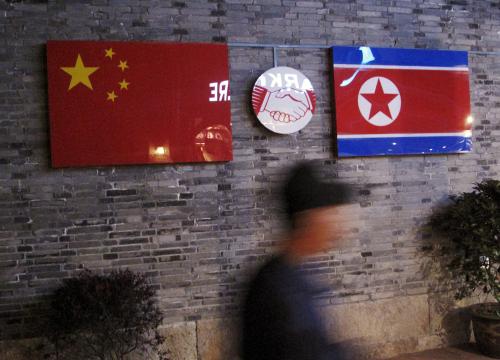The Korean Peninsula typically appears in the U.S. news cycle when North Korean dictator Kim Jong Un issues some blustery comment, or conducts nuclear or missile tests. Or, occasionally, if there is some movement (or not) on denuclearization talks with Washington.
But in recent months, both North and South Korea have been in the news for how they are managing the COVID-19 outbreak. The former touts that it has zero cases, while the latter initially struggled with its spiraling number of cases and then emerged as the model of pandemic crisis management. Both took the disease seriously and understood the potential for severe political and economic consequences, but the two countries’ approaches reveal a yawning gap in their leaders’ respective priorities. All this underscores the difficulty of closing the North-South divide and moving toward meaningful U.S. engagement with North Korean leader Kim Jong Un.
North Korea: Containing coronavirus
North Korea has claimed that there are no cases of coronavirus, touting its swift actions — closing its highly lucrative border with China, instituting quarantines for 10,000 people for a month in various provinces, shutting down tourism — and claiming to be virus-free. In its typical over-the-top language, the party daily exhorted that “work to completely lock down all routes through which the infectious disease can flow in — the border, sea, and air — should be continued with high intensity.”
The propaganda machinery kicked into high gear: Vans equipped with loudspeakers blasted messages about hygiene, photos of citizens wearing masks (some of which were photoshopped) were shown in regime media to highlight the government’s guidance, and workers wearing protective suits sprayed disinfectant in public places. Kim sought to demonstrate his strong leadership, convening a politburo meeting on the disease to warn of “serious consequences” if the virus spread through the country, and called for “unconditionally” obeying regime directives. As of early April, the government was remarkably insisting: “Not one single person has been infected.”
Despite the regime’s denials, North Korea almost certainly has cases of coronavirus, given its location between China, where the pandemic originated and where there have been over 82,000 confirmed cases (and from where a robust flow of traders and smugglers operate along the border with North Korea), and South Korea, with over 10,000 confirmed cases. Reports trickling out of North Korea suggest that coronavirus has affected its citizens. In late March, one regional press reported that over 100 North Korean troops — stationed near the border with China and who had COVID-19 symptoms — have died since February. The commander of U.S. forces in Korea, Robert Abrams, said he was “fairly certain” that the virus has affected North Koreans, indicating that the North’s military has “fundamentally been on lockdown for about 30 days.”
Pyongyang has kept its schools closed, suggesting that the regime is erring on the side of caution or covering up an outbreak. One defector told Reuters: “Hearing from my relatives there, one thing for sure is the situation is very serious.” Pyongyang also quietly requested aid from the World Health Organization and Doctors Without Borders, as well as from Russia and South Korean nongovernmental organizations, suggesting the government recognizes the need for assistance, given its underdeveloped public health infrastructure and the malnourished status of 40% of its population.
South Korea: From pariah to paradigm
While Kim was showing off his control of his country and the virus, the situation just a few dozen miles away in South Korea was the opposite, as the Moon Jae-in administration struggled to get a handle on the emerging crisis. Although medical professionals in mid-January warned about the need for the government to take the strong measures — the first case of coronavirus appeared in Wuhan, China in December — Seoul was seemingly caught flat-footed. Gaffes, misinformation, or contradictory statements from the government; controversy over the handling of a church at the center of the outbreak; the optics of a party Moon hosted for the director of the Oscar-winning movie “Parasite” as the number of confirmed cases doubled from 51 to 104 all contributed to a sense that the situation had spiraled out of the control of an out-of-touch government.
As the country’s confirmed cases ballooned and public frustration mounted, over a million citizens signed a petition for Moon’s impeachment. The number of cases increased every day, reaching a daily peak of 909 new cases on February 29; there are now a total of over 10,000 cases.
But behind the scenes, the government had set in motion a series of actions that would prove critical to its efforts to head off a health catastrophe. In late January, Seoul convened 20 medical companies to urge the rapid production of tests, promising to fast-track government approval. By February 4, the government was shipping tests to where they were needed. Seoul also quickly set up a network of hospitals, clinics, and kiosks — including innovating drive-through testing — and undertook a public education campaign that blanketed the country.
By early March, South Korea was being hailed around the world as the model for how to deal with COVID-19, even as the cases grew to tragic proportions elsewhere, like in Italy and the United States. As of April 2, the government had administered 431,000 tests for its 51 million citizens, or one in every 119 people; by comparison, the U.S. has tested one in 273 people. The Moon administration was lauded for “transparency and competency,” and protecting the public without broad travel bans and lockdowns.
Though still battling a few dozen new cases per day, South Korea has been able to export its expertise. World leaders are calling Moon for advice on best practices and equipment; President Trump in a phone call reportedly asked him for urgent assistance. One South Korean company is producing 350,000 test kits per day, and is planning to export them to around 60 countries, including the United States.
Long overshadowed by its truculent, nuclear-wielding neighbor to the north, the news about South Korea was positive — its managerial, medical, and technological efficiencies touted by global media.
Comparing Koreas
The two countries’ approaches to COVID-19 underscore the difference between a highly personalistic autocracy in North Korea and a dynamic, relatively young democracy in South Korea.
Dependent on the personality cult and the infallibility of the leader, the ideology of juche, or self-reliance, and the constant drumbeat that there is a “hostile” outside world, Kim Jong Un predictably took an approach that protected his image and brand that he has sought to cultivate since he came to power — that of a “modern” North Korea replete with state-of-the-art science and technological facilities, high-end restaurants, hotels, and other accoutrements of a 21st-century consumer culture. To admit that North Korea was affected at all by an infection would be to acknowledge the hollowness of juche and the country’s reliance on trade with China for its livelihood. (China accounts for over 90% of North Korea’s total trade.) At the same time, the global nature of the virus itself symbolizes the danger of integration with the outside world.
The regime handled potential infections the way they treat people who are accused of political crimes or impure thought: with quarantine and removal from the rest of society to prevent the infection from spreading. North Koreans who were tainted by watching South Korean dramas or listening to foreign radio broadcasts would be sent to one of its gulags where torture, rape, forced labor, and death are common. Signaling the lengths the Kim regime was willing to go to keep out potentially impure elements, Chinese officials warned their citizens to stay away from the border with North Korea or risk being shot by North Korean guards. In other words, North Korea was using the threat of violence as a deterrent. And like the unfortunate North Koreans who are secretly shuttled into the gulags, we will never learn about those who die silently from the coronavirus.
Eager to demonstrate that it was business-as-usual, Kim has conducted multiple military drills and ballistic missile tests. The North’s March 12 artillery demonstration showed an unmasked Kim among masked military officers, as if to show his supernatural strength, consistent with decades of Kim family propaganda highlighting omnipotence. Two weeks later, Kim observed the demonstration of a “tactical guided weapon.” Neither he nor his military officials wore masks during these drills and missile tests, reflecting the regime’s confidence that it had the virus under control, at least in Pyongyang, where the elite live. And just ahead of the rubber-stamp Supreme People’s Assembly meeting today, despite the obvious risks it would pose for potential coronavirus infections, Kim was shown guiding a military drill. Again, neither he nor his military officials were wearing masks, and they certainly were not practicing social distancing.
While Kim was protecting his brand of muscular defiance and invincibility, his country a seemingly calm oasis amid the chaos that the coronavirus engendered globally, South Korea’s Moon government, which came to power after year-long peaceful protests that led to his predecessor’s impeachment, was busy testing hundreds of thousands of people. Seoul’s managerial, technological, and medical prowess and reach — combined with a public information campaign — reached into every province, regardless of class or status. It had no choice: With a highly connected and educated populace — nearly 100% of South Koreans have internet access — it would have been impossible to hide a disease outbreak.
Unlike North Korea, the South has a robust civil society unafraid of criticizing the government’s response, signing petitions for the president’s removal, or defying the government’s orders. South Korea’s logistics and knowledge infrastructure, lessons learned from past public health crises as in 2015 with the Middle East Respiratory Syndrome, data-driven policies, commitment and accountability to its citizens (especially given the National Assembly elections this month), and its adherence to international norms of governance and aspirations for excellence provide a stark contrast with Kim Jong Un’s preferred approach of denialism and repression. North Korea consistently ranks at the bottom of the Global Health Security Index — 191 out of 195, just above Syria — under the category “Commitment to improving national capacity, financing, and adherence to norms.” South Korea ranked 23rd, behind Norway. Overall, the South ranks 9th (above Finland, France, and Switzerland), while North Korea is a dismal 193 out of 195, ahead of only war-torn Somalia and poverty-stricken Equatorial Guinea.
Kim Jong Un’s handling of coronavirus is a reminder that the regime prioritizes the cult of personality and the nuclear and ballistic missile program over the lives of its citizens. The regime judges that its claimed nuclear weapons power status is more important than asking for help, and Kim is more interested in his own survival than economic prosperity or a “brighter future” as the Trump administration has been promising. Kim has been lukewarm to Washington’s and South Korea’s offers of humanitarian aid, willing to sacrifice his people on the altar of his hubris, ego, and image. And having inherited and embraced a political culture that rewards sycophancy over expertise, Kim Jong Un, like his father and grandfather, has shown that he has a high tolerance for other people’s pain. The difficulty of negotiating with such a leader should be clear.
Health experts predict that the current crisis may persist well into 2020. Clusters of infections continue to be discovered. Scientists say that a vaccine is a year-and-a-half away, and alarmingly, asymptomatic people are silent carriers of the disease.
South Korea will be ready. But Kim might soon learn that ballistic missile launches are no match for a resilient and deadly virus.
The Brookings Institution is committed to quality, independence, and impact.
We are supported by a diverse array of funders. In line with our values and policies, each Brookings publication represents the sole views of its author(s).







Commentary
A tale of two Koreas in the age of coronavirus
April 13, 2020